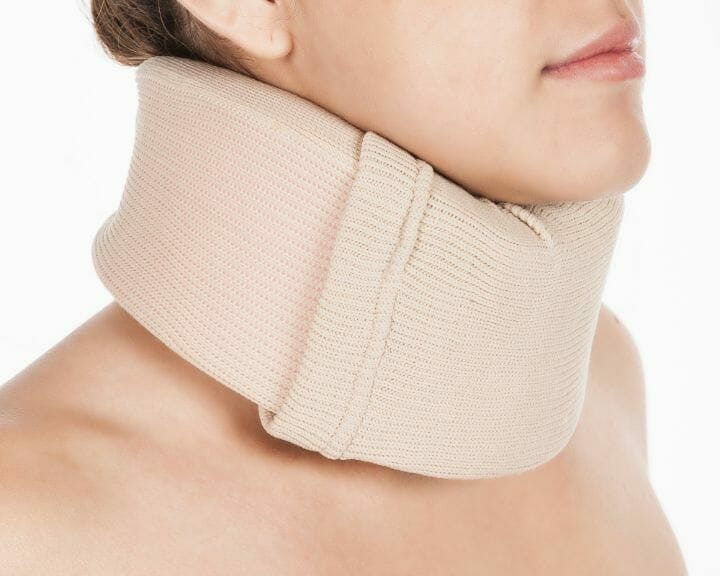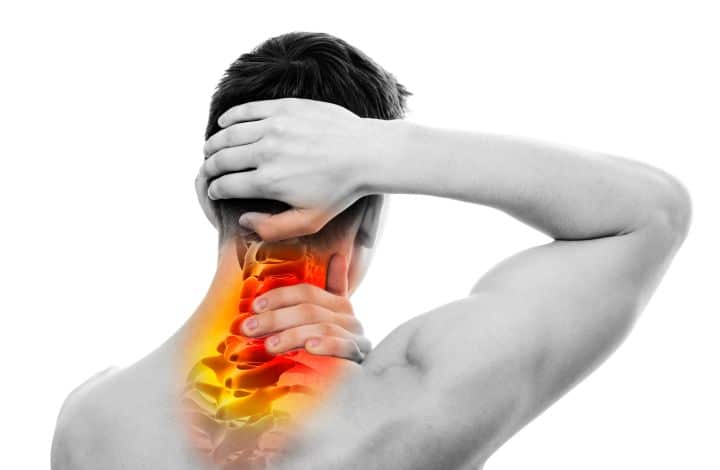The backbone, which runs through a large part of our body consists of several bones (known as vertebrae) separated from each other by intervertebral discs. These intervertebral discs hold the backbone together, allow it to move freely and absorb spinal shock.
Contents
What Is Cervical Spine?
This vertebral column (or spine) is further divided into different regions: cervical, thoracic, lumbar, sacrum, and coccyx, depending on the curvature of the body. The topmost part of the spine, which connects the neck to the back, is known as cervical spine. It consists of 7 bones (C1-C7).
The cervical spine has several roles which are crucial for your body, including:
- Spinal cord protection, which is a set of nerves, whose main task is to carry the brain’s signals to the rest of the body
- It supports the head. The human head on average can be between 10 to 13 pounds.
- Supporting proper blood flow into the brain.
The discs in the spine can get worn out over time, thus reducing the ability of the spine to absorb shocks. It is also possible that space between the vertebrae starts reducing, thus pinching the nerve roots in the spine, which can cause pain and headaches.
What Is Cervical Traction?
Cervical traction is a therapeutic procedure that aims at gently stretching the neck, thus increasing the distance between the intervertebral discs and thereby reducing neck pain.
It can also help to treat cervical radiculopathy (pinched nerves). We have reviewed the best cervical neck traction devices, if you want to have a look at the variety of products available.
What Are the Benefits of Cervical Traction?
Cervical traction improves muscle flexibility, reduces stiffness in the neck, and reduces pain from joints, spasms, and sprains. It is also useful in treating neck injuries and cervical spondylitis, overall improving mobility, alignment, and range of movement. Some problems for which cervical traction might be recommended are:
- Herniated or bulging discs in the neck
- Neck strains
- Cervical muscle spasms
- Compressed Vertebrae
- Dowager’s Hump (upper back hump)
- Muscle Tightness
- Osteoarthritis
- Physical and Mental Stress/Anxiety
- Poor Posture
- Poor Sleep
Below are the benefits to various parts of the body:
- Spine: The ligaments around the spine get stretched by cervical traction. This helps to relax the spinal cord. Blood flow improves, nourishing the neck which was deprived of nutrients without blood flow.
- Neck: Cervical traction helps reduce pain, relieves tension headaches and muscle spasms. It improves the range within which your head and neck can move.
- Blood flow: Blood flow improves significantly to the entire body with the removal of blockages in the neck. This improves oxygen supply to Ligaments, tendons, muscles, and even nerves, which in turn improves mobility.
You may also like Best Exercise Balls To Sit On At Work
Cervical Traction Under Therapist Supervision
Manual: In this type of cervical traction, your therapist will apply a gentle pulling force to your neck and head, alternatively pulling and resting by using his/her hands.
Mechanical: Here the job of the therapist is taken over by a machine that attaches a harness to your head while you’re lying down, and then provides a gentle traction force, which can be controlled by your therapist.
Cervical Traction: DIY
1. Inflatable Air Neck Traction Devices
Air neck traction is done by a device that works as an inflatable neck brace.
The device is secured around your neck and a pump is used to inflate it by hand. As it fills out, it straightens the neck muscles, reduces the weight on the neck to hold the head, and pushes down on your shoulders.
Pros
- These are very easy to use
- They are portable, can easily be carried anywhere
- They can be used in any position
Cons
- Some devices use low-quality material which degrades with usage
- They apply unnecessary pressure on the TMJ and can cause pain in your jaw.
You may also like Best Sit Stand Desk for Home Office
2. Over the Door Traction
A harness is attached to your head and your chin while sitting in a chair, whose other end is strung over a door through a system of pulleys, and the force is applied by using weights or a sandbag/water bag attached to the other end of the rope.
Since this is a DIY method, special precautions should be taken not to stretch too much or apply too much weight. Always consult with your therapist before trying this.
Pros
- Easy to use
- Can be done comfortably sitting on a chair
Cons
- The device is not very portable
- It can take time to find the optimal stretch, till then your chin will have to bear the force
3. Neck Posture Pumps
Posture pumps are self-sufficient traction devices that avoid the problems of over the door traction such as having to mess around with weights and straps around the jaw.
They are generally larger, more durable and provide much stronger traction than other DIY methods. They almost simulate the same effect that you would get a therapists’ machine.
Despite being larger, they are more portable, are softer on the head and jaws, and can be used anywhere (sitting, lying down). However, they are costlier than other devices in this list.
The neck posture pump settles around the head, is secured around the base of your skull and a strap on your forehead. By making adjustments to various setting options, one can specify the amount of pressure that needs to be applied to expand the neck.
Pros
- These devices are usually more robust than over the door traction devices
- They don’t use pillows (like air neck devices), which can leak air
- They don’t impact your jaw like other devices
- Can be carried around easily
Cons
- Less portable than air neck traction devices
- They are an expensive option as compared to other methods
The video below shows how to use neck pumps to improve posture.
You may also like Best Balance Ball Chair For Office
4. Neck Traction Sling
The Neck Hammock is a simple, low-cost option that works by pulling your head away from your shoulders, allowing your neck muscles to relax.
The device comes with a small strap which can be hung over a doorknob. The other end of the strap has a place to hold your head. You can put your head on it and it gives a feeling of your head floating in the air!
There are several caveats with the neck hammock – one has to understand the right height on which to hang it to create any real traction. The material of most available neck hammocks is also not very inspiring.
However, for a cheap and easy to use mechanism that can provide instant relief, there is nothing to beat a neck hammock.
Pros
- Easy to use
- Inexpensive
- Extremely portable
- Doesn’t impact your jaw in any way
Cons
- The traction provided is questionable – you have to adjust it to the right height
- Most neck hammocks available in the market are made of poor quality material
5. DIY Neck Hammocks
Looking at the simplicity of a neck hammock, a lot of people have experimented with building one at home through materials easily available.
Ideally, you should not try such shenanigans since any mistake could cause accidents and aggravate the existing problems.
However, it is possible to build a DIY neck hammock, albeit if done carefully:
- Use a folded towel or create multiple folds on a sheet of cloth that is composed of good fibre strength
- Create holes on each side, for the strap
- Insert a rope in the holes. The trick here is to find the right length of rope, which can be done only with some hit and trial.
Pros
- Free to make!
- Portable, quickly available
Cons
- Any error can lead to an accidental fall and aggravate the existing problem
You may also like Best Anti Fatigue Mat for Standing Desk
How Long Should You Do Cervical Traction?
There is no fixed or set time limit for carrying out cervical traction. It depends on how much pain is felt, the stamina of the sufferer and the availability of time to do it.
Pain in itself is a variable quantity. Sometimes, there might be aggravating circumstances that cause extreme pain in the head and neck (such as a long day at work, or having to lift a heavy load).
Other days, there may be no pain at all. The amount of time one spends on traction should depend on how badly pain relief is needed, and ideally, it should not follow a set standard. That said, most therapists recommend starting with 10 minutes a day and moving ahead to 20 minutes as per your needs.
Conclusion
Neck pain is a major problem today in most adults working in white-collar jobs, which require having to hunch over a laptop or electronic device for the large part of the day. Bad posture, long days at work, poor eating habits, and lack of exercise can all lead to the intervertebral discs wearing out or getting aggravated, leading to pain in the neck and shoulders.
While traditional medicine, neck surgery, and therapy are usually expensive and require investing a lot of time and effort, cervical traction offer hope in the form of an easy, cheap, and effective method to relieve pain. By stretching the head away from the shoulders, the cervical cord is allowed to expand and heal itself by easing out pinched nerves and increasing blood flow by removing blockages.
When coupled with regular visits to your therapist and proper rest, diet, and posture, cervical traction can help bring about a quick recovery from chronic neck pain. There are several easy to use devices available to carry out cervical traction in the comfort of your home, by merely spending 10-20 minutes every day.


